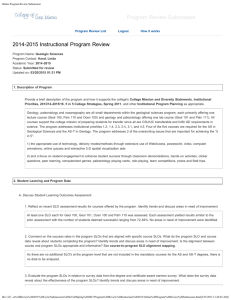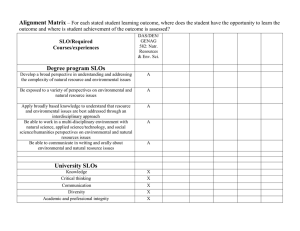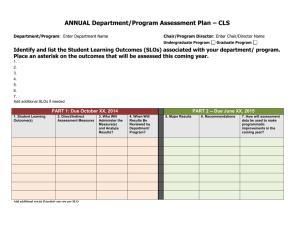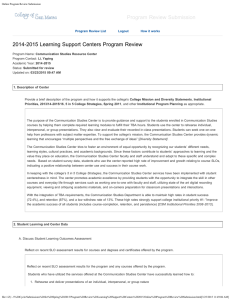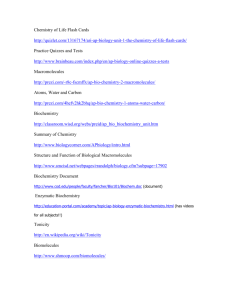Program Review Submission 2014-2015 Instructional Program Review
advertisement
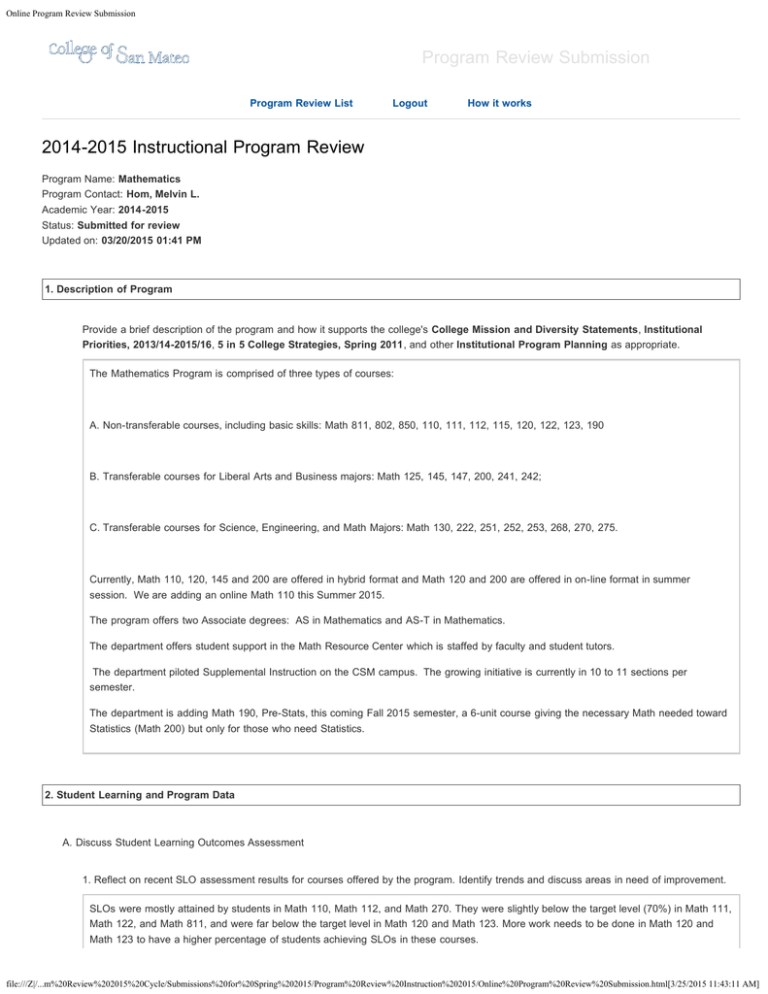
Online Program Review Submission Program Review Submission Program Review List Logout How it works 2014-2015 Instructional Program Review Program Name: Mathematics Program Contact: Hom, Melvin L. Academic Year: 2014-2015 Status: Submitted for review Updated on: 03/20/2015 01:41 PM 1. Description of Program Provide a brief description of the program and how it supports the college's College Mission and Diversity Statements, Institutional Priorities, 2013/14-2015/16, 5 in 5 College Strategies, Spring 2011, and other Institutional Program Planning as appropriate. The Mathematics Program is comprised of three types of courses: A. Non-transferable courses, including basic skills: Math 811, 802, 850, 110, 111, 112, 115, 120, 122, 123, 190 B. Transferable courses for Liberal Arts and Business majors: Math 125, 145, 147, 200, 241, 242; C. Transferable courses for Science, Engineering, and Math Majors: Math 130, 222, 251, 252, 253, 268, 270, 275. Currently, Math 110, 120, 145 and 200 are offered in hybrid format and Math 120 and 200 are offered in on-line format in summer session. We are adding an online Math 110 this Summer 2015. The program offers two Associate degrees: AS in Mathematics and AS-T in Mathematics. The department offers student support in the Math Resource Center which is staffed by faculty and student tutors. The department piloted Supplemental Instruction on the CSM campus. The growing initiative is currently in 10 to 11 sections per semester. The department is adding Math 190, Pre-Stats, this coming Fall 2015 semester, a 6-unit course giving the necessary Math needed toward Statistics (Math 200) but only for those who need Statistics. 2. Student Learning and Program Data A. Discuss Student Learning Outcomes Assessment 1. Reflect on recent SLO assessment results for courses offered by the program. Identify trends and discuss areas in need of improvement. SLOs were mostly attained by students in Math 110, Math 112, and Math 270. They were slightly below the target level (70%) in Math 111, Math 122, and Math 811, and were far below the target level in Math 120 and Math 123. More work needs to be done in Math 120 and Math 123 to have a higher percentage of students achieving SLOs in these courses. file:///Z|/...m%20Review%202015%20Cycle/Submissions%20for%20Spring%202015/Program%20Review%20Instruction%202015/Online%20Program%20Review%20Submission.html[3/25/2015 11:43:11 AM] Online Program Review Submission 2. Comment on the success rates in the program SLOs that are aligned with specific course SLOs. What do the program SLO and course data reveal about students completing the program? Identify trends and discuss areas in need of improvement. Is the alignment between course and program SLOs appropriate and informative? See course-to-program SLO alignment mapping. Program SLOs are aligned with course SLOs in all courses from Math 251 (Engineering Calculus) and higher, which would be Math 251, 252, 253, 268, 270, 275, and 329. 3. Evaluate the program SLOs in relation to survey data from the degree and certificate award earners survey. What does the survey data reveal about the effectiveness of the program SLOs? Identify trends and discuss areas in need of improvement. Among responders to the survey for AS and AS-T degrees, over 80% responded that they either agreed or agreed strongly with all 11 Program SLOs. This would indicate that a student who earns an Associates degree in Mathematics from CSM is able to perform the program SLOs. 4. Describe any additional methods used to assess program SLOs and reflect on the results of those assessments. The survey referred to in question 3 above was the only method used to assess program SLOs. 5. For any courses in the program that satisfy a GE requirement, which GE SLOs are supported or reinforced by the course SLOs? What do assessment results for the course SLOs reveal about student attainment of the GE SLOs? See GE SLO Alignment Summary Report or All Courses GE SLO Alignment Data. All Mathematics courses which satisfy a GE requirement satisfy the Quantitative Skills and Critical Thinking GE SLOs. B. Student Success Indicators 1. Review Student Success and Core Program Indicators and discuss any differences in student success indicators across demographic variables. Also refer to the College Index and other relevant sections of the Educational Master Plan: Update, 2012, e.g., Student Outcomes and Student Outcomes: Transfer. Basic Skills programs should also refer to ARCC data. The Mathematics Department has had a steady rate of success, retention, and withdrawal rates over the past 3 years, with overall success being about 58%, retention rate about 76%, and withdrawal rate about 24%. Among African-Americans and Hispanics, the success rate was about 50% in 2013-2014. Asians continue to have the highest success rate at about 68%, followed closely by Whites at 63%. There are consistently more males than females taking Math courses (3032 males in '13-'14 compared to 2398 females; similar ratios were seen in prior years). For the past several years the percentage of Math students taking a transferable course has been increasing from about 46% in 20112012 to 48% in 2013-2014. The percentage of students taking a Degree-Applicable course has been about 19%-20% for several years. The percentage of Math students taking Basic Skills courses has been about 32%-33% for several years. We are enthusiastic about the opportunity to include collaborative workspaces within the new Emerging/Innovative Technologies Building. These workspaces – a “design space” equipped with whiteboards, multi-purpose computer labs, and a “tech shop” to support prototyping – would allow students to work in interdisciplinary teams and extend what they learn in the classroom to more advanced projects. Students would gain hands-on experience as they prepare for internships and transfer. Projects could go beyond what is currently possible in a single course, making it easier to attract support from local businesses and industry. We look forward to working with faculty in other disciplines to develop the physical and curricular infrastructure for this effort. file:///Z|/...m%20Review%202015%20Cycle/Submissions%20for%20Spring%202015/Program%20Review%20Instruction%202015/Online%20Program%20Review%20Submission.html[3/25/2015 11:43:11 AM] Online Program Review Submission 2. Discuss any differences in student success indicators across modes of delivery (on-campus versus distance education). Refer to Delivery Mode Course Comparison. Comparisons made here are for the combined Fall semesters of 2011, 2012, and 2013. For Math 110, Distance Ed success rate was 21% compared to 60% for traditional classes. This has been a problem for several years at CSM. Math 120 had a bit more success in Distance Ed mode, with 44% success in Distance Ed mode compared to 59% in the traditional mode. Math 145 had a higher success rate with Distance Ed (68%) compared to the traditional mode (58%). Math 200 had comparable rates with 57% in Distance Ed mode compared to 59% in traditional mode. So more needs to be done to raise the success rates in the Algebra courses (Math 110 and Math 120). C. Program Efficiency Indicators. Do we deliver programs efficiently given our resources? Summarize trends in program efficiency as indicated in the Student Success and Core Program Indicators (LOAD, Full-time and Part-time FTEF, etc.) The LOAD has gone from 543.2 in 2011-2012 to 574.3 in 2012-2013 to 526.5 in 2013-2014, consistently higher than the division and college total. The Full-time FTEF has gone from 24.9 in 2011-2012 to 22.1 in 2012-2013 to 25.2 in 2013-2014. Adjunct FTEF has gone from 24.3 in 2011-2012 to 26.6 in 2012-2013 to 26.1 in 2013-2014. The Percent of Full-time has remained at roughly 50%, from 51.7% in 2011-2012 to 46.6% in 2012-2013 to 50.6% in 2013-2014, consistently lower than the college average and Math-Science Division average. 3. Additional Factors Discuss additional factors as applicable that impact the program, including changes in student populations, state-wide initiatives, transfer requirements, advisory committee recommendations, legal mandates, workforce development and employment opportunities, community needs. See Institutional Research as needed. According to the Educational Master Plan, San Mateo County is projected to have an increase in demand for biological science, physical science, and computer science majors. Math is required in all of these fields. 4. Planning A. Results of Program Plans and Actions Describe results, including measurable outcomes, from plans and actions in recent program reviews. We were able to hire 2 new full-time faculty for the 2014-2015 school year; however, we are anticipating two full-time faculty members retiring in the next 3 years, both with a heavy load in statistics. We are lookng to hire at least one full-time faculty member with expertise in statistics (while still being able to teach the entire breadth of courses in Mathematics). We have added Math 110 online/hybrid for the summer 2015. B. Program Vision What is the program's vision for sustaining and improving student learning and success over the next three years? Make connections to the College Mission and Diversity Statements, Institutional Priorities, 2013/14-2015/16, and other Institutional Program Planning as file:///Z|/...m%20Review%202015%20Cycle/Submissions%20for%20Spring%202015/Program%20Review%20Instruction%202015/Online%20Program%20Review%20Submission.html[3/25/2015 11:43:11 AM] Online Program Review Submission appropriate. Address discussion in the Student Learning and Program Data section: SLO assessment results and trends in student success indicators. [Note: Specific plans to be implemented in the next year should be entered in C of the Planning section. CTE programs must address changes in the context of completion and employment rates, anticipated labor demand, and any overlap with similar programs in the area as noted in D1 and D2 of the Career Technical Education section.] The mathematics department sees its program as essentially three different but interconnected programs. Since the three programs provide unique challenges, each will be addressed separately in this program vision, then common needs will be discussed. 1. Developmental Math – Developmental Mathematics facilitates success and persistence among students in basic skills and belowtransfer level mathematics. The courses support student completion of certificates, AA/AS degrees, and general education requirements. As indicated in SLO discussions above and in prioritized plans below, student success and persistence in basic skills mathematics and below transfer level mathematics has long been a departmental concern. However, the current and on-going emphasis on mastery of an identified set of concepts/skills in the algebra sequence seems to be working. We envision a department that will continue to assess progress in student success and persistence in this sequence and who will cooperatively and collaboratively address new challenges as they arise. The Math 811 initiative is an example of this department culture in action. After much discussion and research into what seems to be working elsewhere the consensus was that math 811 students need more time on task, need counselor intervention when life and/or immaturity block success and need to learn how to be students as much as they need to learn arithmetic. We kept running into obstacles, but finally a plan came together and was launched in Fall 2013. As stated in the SLO section above this collaborative effort shows promise. However, the plan only came together when a group of full-time faculty who do not usually teach Math 811 determined to be core faculty at that level for at least the next year and counseling faculty were identified to be part of the project. The SI program is part of this promising Math 811 collaboration. The SI program is another example of faculty working together to support a program that supports student success. The Math department envisions SI sections available for all below transfer level math courses. The department needs more full time faculty who will dedicate part of their time to taking the lead in developmental mathematics initiatives. 2. Transfer Level Sequence– Transfer level courses meet the needs of students intending to transfer in social science, nursing, and liberal arts programs. Again, cooperation and collaboration among faculty has led to improved student success at this level. A statistics “team” evolved over time that now includes both full-time and part-time faculty, and rich conversation between those using traditional and non-traditional approaches to teaching statistics. We envision deliberate development of teams of faculty who work together to develop strategies and pedagogies that improve student success and persistence at this level. As indicated in SLO discussions above, such an effort is bringing promising results in Math 125. We envision this type of collaboration and sharing developing around other courses at the Transfer Level. However, the department needs full-time faculty interested in these courses and in taking the lead in the effort to develop a faculty team in support of students at this level. 3. Calculus Sequence–The calculus sequence (and beyond) meets the needs of students who desire to earn an AS or AS-T in Mathematics and students intending to transfer into STEM majors. As indicated above, SLO success and student success and persistence are highest at this level. These courses are the most mathematically challenging to teach and also, the easiest to teach. Most students arrive with acceptable ‘student’ skills. Here the challenge is to stretch the students to application in context. The department needs more multi-faceted faculty capable of challenging and being challenged by these students and at the same willing and able to accept the very different challenges of the other two sequences. Thus we envision an enlarged full-time faculty willing and capable of taking the lead in multiple sequences of the program. We envision a faculty (full-time and adjunct) dedicated to learning and growing as instructors, with the ultimate goal of guiding as many students as possible to success in their educational goals, whether that goal be a certificate, a non-STEM AA, transfer to a non-STEM degree, or transfer to a STEM degree. 1. To guide future faculty and staff development initiatives, describe the professional activities that would be most effective in carrying out the program's vision to improve student learning and success. file:///Z|/...m%20Review%202015%20Cycle/Submissions%20for%20Spring%202015/Program%20Review%20Instruction%202015/Online%20Program%20Review%20Submission.html[3/25/2015 11:43:11 AM] Online Program Review Submission Professional development should be relevant and immediately applicable to the classroom. We encourage support for special rate funds that allow adjunct faculty to work more closely with other faculty in learning new strategies/skills, developing and enacting those ideas, and evaluating the impact on student success. We would like to see more presentations by CSM faculty to CSM faculty to encourage growth of Supplemental Instruction, Reading Apprenticeship, and other recognized “best practices” in support of student success. 2. To guide future collaboration across student services, learning support centers, and instructional programs, describe the interactions that would help the program to improve student success. The faculty leads of the Math Resource Center are active participants in the Learning Support Centers Coordination Committee (LSC3). We will continue to work together to seek ways to best provide student success support while becoming more efficient in how we offer services, seeking to identify and reduce duplications and investigating how by acting as a unit we can employ economies of scale. Last year’s endeavors have given us a much better understanding of the roles played by the many centers on campus and lead to discussion of how we might better serve students by consolidation of services at times when our individual labs are not usually open (evenings and weekends). This idea needs further investigation especially with respect to increased funding for staff and faculty assignments and the logistics of collecting SARS data for TBA requirements when faculty with the appropriate FSA are on duty. Mathematics faculty have a history of working together with the BSI committee to support and improve success among basic skills students. We would like to see the current Supplemental Instruction program become institutionalized and branch out into other disciplines and know there is some interest elsewhere within our division. The Math 811 planning group has requested counseling faculty designated to work more closely with developmental mathematics faculty. We have evidence from our learning community experience that this interaction does lead to increased student success. We would like to see such partnerships continued and further developed. Within the Math Science Division a multi-disciplinary group is working together and learning together in Reading Apprenticeship. Currently Reading faculty are working and learning with us with goals of becoming better teachers and increasing student success. We would like to see this interdisciplinary effort continue to grow. 3. To guide the Institutional Planning Budget Committee (IPBC) in long-range planning, identify any major changes in resource needs anticipated during the next three years. Examples: faculty retirements, equipment obsolescence, space allocation. See the Resource Requests section below to enter itemized resource requests for next year. Leave sections blank if no major changes are anticipated. Faculty One full-time faculty member has stated an intent to retire in in the next 3 years, and another within 5-10 years.We need to hire more new faculty now so that new faculty benefit from the institutional memory of the well-seasoned faculty and programs continue without interruption. We also need full-time instructors who can teach Statistics, since we will have lost two full-time faculty who regularly teach Statistics in the next few years. Mathematics supports additional faculty and funding for Counseling, so that their faculty can continue to collaborate with math faculty in the Math 811 project. Equipment and Technology Computers are useful in helping to increase arithmetic and algebraic skills for students in Math 811, 110, 111, and 112 (i.e. Basic Skills file:///Z|/...m%20Review%202015%20Cycle/Submissions%20for%20Spring%202015/Program%20Review%20Instruction%202015/Online%20Program%20Review%20Submission.html[3/25/2015 11:43:11 AM] Online Program Review Submission courses). Computers are also helping in honing skills for Math 120 (Intermediate Algebra) students. There is a need for a second computer lab/classroom to aid in teaching Basic Skills Mathematics, as the present lab/classroom in 16-111 is fully employed for teaching statistics, and is designed for collaborative work (only 20 computers) is not large enough for the estimated demand. Optimal location for this additional classroom will be adjacent to the Math Resource Center with a connecting door and large windows in the wall so that the room may double as an extension to the MRC when classes are not in session. In 2016, the 21 computers in 16-111, the statistics computer classroom will have reached their life expectancy and should be replaced. Projectors in building 16 and 18 have been in service for quite a while, so a replacement plan needs to be developed. Several classrooms used for Mathematics can become unbearably hot because of the dark shades that are in the rooms. We are asking to replace these shades with lighter shades which would reflect, rather than maintain, the heat. It is not only a difficult learning environment for both students and teachers, but it could potentially be a health hazard for some people to be in rooms which could possible be in the 90's in temperature. The specific classrooms that we are asking for lighter shades are 18-203, 18-301, 18-303, 18-305, and 18-307. We are asking for a pair of blinds for each classroom - one shear and one opaque. We need another 4 ft x 7 ft whiteboard in the building 15 Math corridor, specific location between 15-127 and 15-129, in order to accommodate the large number of Math students who wish to have board space and work on Math problems near the offices of Math Department instructors. Presently, there are 2 whiteboards in the Math corridor but they are not sufficient for the needs of the Math Department instructors and students. Instructional Materials Traditional publishing companies provide copies free to instructors but charge students large amounts to purchase their personal copies of the text. A growing subset of the mathematics faculty are selecting high quality open-source text book that are offered inexpensively to students. The open-source publishers do not provide complementary texts to faculty and to learning centers. Many publishers only make solution manuals available to faculty as e-versions (previously we could get them as free print copies). Funds will be needed to purchase print texts and solutions manuals for faculty who prefer print. (See complete discussion in Math Resource Center Program Review.) Classified Staff Classified staff is needed to support the SI program and release the faculty lead from administrative and data collection to spend more time actually teaching. For the current year, we support the increase of classified staff dedicated to the SI program; we recognize that this person will be serving the college as a whole, not just mathematics. The Math Resource Center requests a less than full-time Instructional Aid (see Math Resource Center Program Review). Facilities The department is currently seeking replacement shades in mathematics classrooms due to heat absorption issues that make the classrooms overly warm. Some funding was received in 2013-2014 and several classrooms are scheduled for replacement shades. We would like to see the remaining funding during 2015-2016. It should be of utmost importance for the learning environment and also the health and safety of people in these classrooms that they not become overheated. The specific classrooms we are looking for are 18-203, 18-301, 18-303, 18-305, and 18-307. We are looking for double shades in each room - one shear and one opaque (similar to those presently in 18-201). Cabling and extension cords in 16-111, the statistics computer classroom, are constantly on the floor. We are looking for solutions to this problem and may make a request of facilities in the future. The department is again requesting an additional computer classroom, preferably adjacent to the current Math Resource center. The department requests a third white board mounted in the hallway outside our offices in building 15. The hallway has become our extended office space and provides a way for instructors to interact with multiple students simultaneously and for small groups of students to work on problem solving within close proximity of their math faculty. file:///Z|/...m%20Review%202015%20Cycle/Submissions%20for%20Spring%202015/Program%20Review%20Instruction%202015/Online%20Program%20Review%20Submission.html[3/25/2015 11:43:11 AM] Online Program Review Submission C. Program Plans and Actions to Improve Student Success Prioritize the plans to be carried out next year to sustain and improve student success. Briefly describe each plan and how it supports the Institutional Priorities, 2013/14-2015/16. For each plan, list actions and measurable outcomes. (Plans may extend beyond a single year.) Plan 1 Title: Math 811 Development Group Description The Math 811 Development Group (Plan 1 2014) is completing year two of its grant. The department will continue to offer Math 811 in its 5 contact hour format, to encourage collaboration between Math 811 faculty, and supports the Couonseling Dean's request for funding to institutionalize the collaboration between Math 811 faculty and Counseling Faculty. More counseling hours are needed to effectively continue this promising collaboration. Action(s) Completion Date Measurable Outcome(s) Continue for academic year 2014-2015 Summer 2015 Mid-year and end of year SLO and student success reports. Plan 2 Title: Algebra Sequence Focus (year 3) Description We have requested multi-year data from PRIE for analysis. The course outlines have been updated to reflect curricular division implemented in 2011. file:///Z|/...m%20Review%202015%20Cycle/Submissions%20for%20Spring%202015/Program%20Review%20Instruction%202015/Online%20Program%20Review%20Submission.html[3/25/2015 11:43:11 AM] Online Program Review Submission Action(s) Completion Date Measurable Outcome(s) Plan 3 Title: Supplemental Instruction Description SI was institutionalized in 2014. Within Math the program continues to grow and is desired by both students and faculty. Action(s) Completion Date Measurable Outcome(s) SI implemented in Fall 2014 Spring 2015 Reports submitted to campus lead SI implemented in Spring 2015 Summer 2015 Reports submitted to campus lead For additional plans, cut/paste from above and insert here. Or add an additional page. Number your additional plans accordingly. 5. Resource Requests Itemized Resource Requests List the resources needed for ongoing program operation. file:///Z|/...m%20Review%202015%20Cycle/Submissions%20for%20Spring%202015/Program%20Review%20Instruction%202015/Online%20Program%20Review%20Submission.html[3/25/2015 11:43:11 AM] Online Program Review Submission Faculty NOTE: To make a faculty position request, complete Full-time Faculty Position Request Form and notify your Dean. This request is separate from the program review. Full-time faculty requests Number of positions Mathematics Instructor 1 Equipment and Technology Description Cost New Computer Classroom (computer costs only - HP Thin Clients with monitors or current recommended configuration) $25,000 Instructional Material Classified Staff file:///Z|/...m%20Review%202015%20Cycle/Submissions%20for%20Spring%202015/Program%20Review%20Instruction%202015/Online%20Program%20Review%20Submission.html[3/25/2015 11:43:11 AM] Online Program Review Submission Description Cost Facilities For immediate or routine facilities requests, submit a CSM Facility Project Request Form. Description Cost Refit of classroom to support computer classroom $50,000-$100,000 Furniture for refitted classroom - tables and chairs for 40 students (assuming existing instructor table, podium, projector would remain) $12,000-$15,000 Replacement blinds (2 per classroom, white opaque and white shear), 18203, 18-301, 18-303, 18-305, 18-307 $40,000 Whiteboard, 4ft x 7ft, in Math corridor of building 15, specifically between 15127 and 15-129, for students to work with instructors on Math problems $300-$500 6. Program Maintenance A. Course Outline Updates Review the course outline update record. List the courses that will be updated in the next academic year. For each course that will be updated, provide a faculty contact and the planned submission month. See the Committee on Instruction website for course submission instructions. Contact your division's COI representatives if you have questions about submission deadlines. Career and Technical Education courses must be updated every two years. file:///Z|/...m%20Review%202015%20Cycle/Submissions%20for%20Spring%202015/Program%20Review%20Instruction%202015/Online%20Program%20Review%20Submission.html[3/25/2015 11:43:11 AM] Online Program Review Submission Courses to be updated Faculty contact Submission month None to be updated Spring 2015 B. Website Review Review the program's website(s) annually and update as needed. Faculty contact(s) Date of next review/update Robert Hasson Fall 2015 Lena Feinman (MRC pages) Fall 2015 C. SLO Assessment Contacts Faculty contact(s) Date of next review/update Harry Nishanian Fall 2015 file:///Z|/...m%20Review%202015%20Cycle/Submissions%20for%20Spring%202015/Program%20Review%20Instruction%202015/Online%20Program%20Review%20Submission.html[3/25/2015 11:43:11 AM] Online Program Review Submission In transfer level courses (non-major courses) a follow-up assessment on one SLO (out of 6 to 10 SLOs per course) is not unusual. Faculty awareness of trouble spots and subsequent changes in pedagogy or time-on-task usually leads to a satisfactory assessment within one year. At below transfer level and basic skills a "problem area" is almost consistently identified and vary from semester to semester. file:///Z|/...m%20Review%202015%20Cycle/Submissions%20for%20Spring%202015/Program%20Review%20Instruction%202015/Online%20Program%20Review%20Submission.html[3/25/2015 11:43:11 AM]
